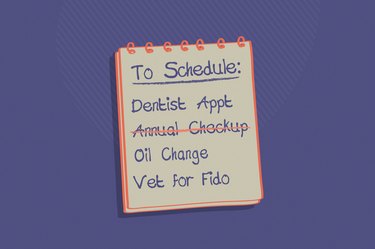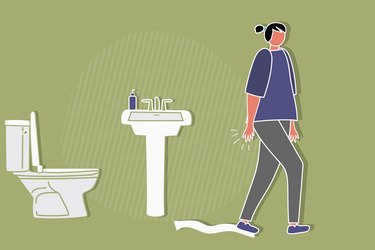
You went to the ER or urgent care to get stitches for a nasty laceration. Now the wound looks basically healed (thanks, smart cut care and healthy habits) and like it's time for the sutures to come out. Instead of making another trek to the doctor, can you just do it yourself?
That's a hard no, experts say. "Technically it's possible to remove your own stitches. But you shouldn't do it, for a few different reasons," says Anjali Bharati, DO, emergency room physician at Lenox Health Greenwich Village in New York.
Video of the Day
Video of the Day
Here's a look at why it's a really, really good idea to have an expert remove your stitches rather than try to take them out at home. Plus, where to get it done if you don't have insurance.
The Risks of Taking Out Your Own Stitches
A few different things can happen when you try to do DIY stitches removal. And none of them are pretty.
The Wound Could Open Back Up
The biggest risk of taking out your own stitches is doing it too early, before the wound edges have had a chance to begin closing. "If you do that, it could open back up. That's the biggest problem," says Hannah Goldberg, MD, a primary care physician with Mercy Health Services in Baltimore.
Doctors call this dehiscence, and it can get pretty unpleasant. Dehiscence can cause an injury to start bleeding or leaking fluid again, which can increase the risk for infection, per the U.S. National Library of Medicine (NLM). Reopening the wound will make it take longer to fully heal too.
You Could Get an Infection
Stitches are typically removed when a wound is mostly — but not completely — closed up. And since it's still partially open, it's prone to becoming infected if the wrong microbes make their way into the affected area.
That's more likely to happen if you try to take your stitches out in an unsterile environment … like your home. "The instruments you have at home likely aren't sterilized. Even when they're exposed to dust or air, they can have dust or bacteria that could expose you to an infection," Dr. Bharati says.
And sure, an infected wound can heal with proper at-home care (a healthy diet can be helpful too). But there's also a chance that it gets bad enough that you end up having to go back to the doctor anyway for antibiotics. In very rare cases, the infected area might even require a skin graft, Dr. Bharati warns.
You Might Let the Stitches Stay in Too Long
While taking stitches out too early is the bigger concern, taking them out too late isn't good either.
"We remove the stitches in a certain timeframe so as not to cause any reaction from a retained foreign body," Dr. Bharati says. That reaction could be an infection, which the body may launch in an attempt to get the foreign invader (that is, the stitches) out.
Stitches that overstay their welcome can be harder to get out too. "The skin can start to grow over the stitches," Dr. Bharati says. And if you're picking and prodding at your skin to pull out the sutures, you run the risk of reinjuring the wound (sort of like picking at a scab, but worse).
You Miss Out on Follow-Up Care
When a health care provider removes stitches, they also check to see how the wound is healing. They'll check for fluid buildup or other signs of infection that might require treatment with antibiotics, for instance. "Sometimes we may need to do secondary wound care, like applying a Steri-Strip, if healing is taking a little bit longer, since stitches can only stay in for so long," Dr. Bharati adds.
But when you take out your stitches yourself, you skip the chance to have an expert take that all-important second look.
Tip
There are some incision closures – such as dissolvable stitches and tissue glue — that do not need to be removed by a health care provider, since they'll naturally dissolve, or, in the case of tissue glue, fall out, per the Cleveland Clinic.
Alternatives to Removing Stitches Yourself
It can be tempting to play doctor if you don't have insurance or worry that you can't afford to cover the cost of having your stitches taken out. But you might not actually have to pay anything: In many cases, the cost for stitches removal and follow-up care is included in the fee you already paid to have the stitches put in, Dr. Goldberg says.
If you're not sure, just give the health care facility a call and ask.
Many hospitals and health centers also provide free or low-cost care on a sliding scale for people who are uninsured or can't afford to pay, according to the U.S. Department of Health & Human Services. You can search the national directory of affordable health centers at findahealthcenter.hrsa.gov.
Related Reading
How Long Should Stitches Stay In?
Timing with stitches isn't one-size-fits-all. "It depends on the part of the body and the injury," Dr. Bharati says. Most are removed within three days to three weeks, per the American Academy of Family Physicians (AAFP).
Your health care provider will let you know when your stitches should come out and when to come back for follow-up care.
So, How Bad Is It Really to Remove Your Own Stitches?
Trying to take out your own stitches can be dangerous, since it can cause the wound to reopen or put you at risk for an infection. And since having them taken out by a health care provider is often free (or low-cost), there's really no reason to DIY it.
Bottom line: "It's just not something you should do if you want to take good care of your wound," Dr. Goldberg says.
Was this article helpful?
150 Characters Max
0/150
Thank you for sharing!
Thank you for your feedback!
Is this an emergency? If you are experiencing serious medical symptoms, please see the National Library of Medicine’s list of signs you need emergency medical attention or call 911.



